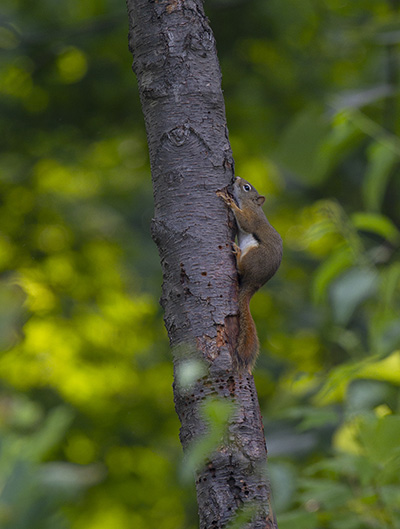Red Squirrel
(Tamiasciurus hudsonicus)
 Description & Range:
Description & Range:
Red squirrels are smaller than gray squirrels and are more red in color. Their most noticeable characteristics are the tail and eye ring. The tail is bushy and red on the upper surface, and the eye ring is a thick, white circle around the eye. They have reddish-gray or rust-colored fur and a white belly, with some individuals having a black stripe along their side. They are typically 11-13 inches long and weigh 4-8 ounces. Their maximum life span is 10 years in the wild.
Red squirrels have a wide range, including Canada, Alaska, the eastern Rocky Mountains, the northern Midwest, New England, and south along the Appalachian Mountains. In Maryland, they are primarily found in the western part of the state, particularly Garrett County, but maintain a presence in other counties west of the Chesapeake Bay where suitable habitat exists.
Habitat:
Red squirrels prefer evergreen trees, and often live in coniferous forests with spruce, eastern hemlock, pine, and balsam fir trees. They can also be found in mixed deciduous-coniferous forests. Red squirrels are commonly observed in mature spruce and pine plantations such as those in New Germany State Park.
Diet:
The main part of their diet is the seeds and cones of evergreen trees. When available, they will also eat nuts, fungi, fruit, and bird eggs. They are even known to tap sugar maple trees to feed on the sugary sap.
Reproduction:
Red squirrels prefer to nest in tree cavities, but will also make ball nests on tree branches or dwellings in underground burrows. They make their nests out of shredded bark, lichen, grass, leaves, and twigs. They will typically bear 1-2 litters of young each year beginning in the spring, with a litter size of 4-7 babies.
Sounds:
Red squirrels are very vocal with a variety of different sounds and calls. They have a lengthy, descending trill, as well as various chirps, chucks, rattles, and squeaks. When alarmed, they may produce a sharp bark that is repeated for an hour or more.
Behavior:
Highly individual and territorial, red squirrels will defend their territory aggressively and will not let other squirrels, even of different species, into their habitat. They are active year-round, and will collect and hide seeds and nuts for storage that they will dig up and eat during the winter when food is scarce. Red squirrels will often create midden structures at the base of feeding trees that consist of accumulated conifer cone scales, a result of their tendency to repeatedly feed in the same spot. These structures may be utilized to a limited extent as climate-stable places to bury food caches. Red squirrels are also known to dehydrate food items such as mushrooms by hanging them until dry.
Management:
Red squirrels are considered common and are managed as a small game species in Maryland. There is an annual hunting season that has established regulations and bag limits. To learn more about small game management and hunting regulations, click here. To learn more about squirrels and their management in Maryland, visit the Squirrels in Maryland page.
Sources:
https://dnr.maryland.gov/wildlife/Pages/habitat/wasquirrel.aspx
https://www.marylandbiodiversity.com/view/789
https://extension.umd.edu/sites/extension.umd.edu/files/2021-03/FS607_WMgtSquirrel.pdf
https://www.nwf.org/Educational-Resources/Wildlife-Guide/Mammals/Red-Squirrel
Peterson Field Guide to Mammals of North America, Fourth Edition
- Photo: Red Squirrel in Garrett Co, by Bill Hubick (MBP)